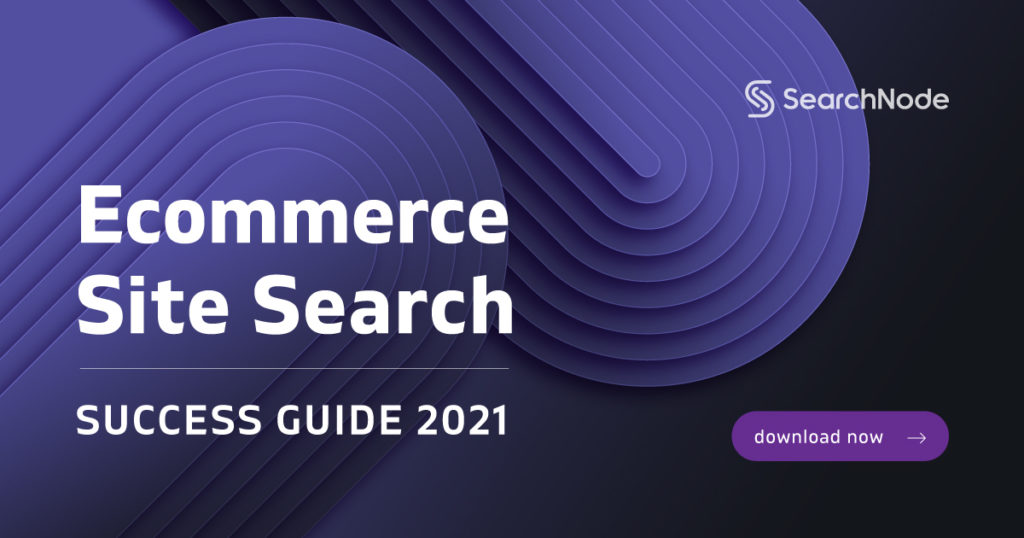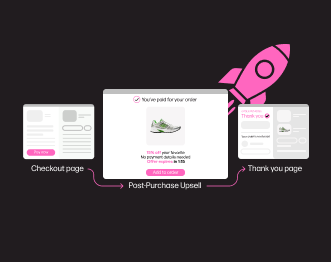How Do eCommerce Leaders Constantly Grow Site-Search Conversion Rate? An Ultimate 4 Steps Framework
Nobody can argue that eCommerce site-search is a crucial part of any online store strategy. In fact, 60% of eCommerce leaders said that they plan to implement, improve, or change their site-search in 2020. If done right, site-search can tremendously increase your site usage, sales, conversion rates, not to mention that it can positively influence your branding, and customer loyalty. But simply having a site-search implemented, and not doing anything with it, is just like buying quality running shoes, and not using them to run a marathon – it does it’s function, but you never use a full potential of it.
Site search is an organic thing – users are coming to your online store, typing their search queries, basically telling you what they would like to buy. This generates loads of valuable data for you. The important thing is what you do with it? You have to utilize it for your own benefit, and you have to find the best algorithms and the best configuration to match those search queries with the products to maximize the conversion rates.
This article will not focus on some tips & tricks on how to quickly improve your site-search, by making some design tweaks, like “make your search box easy to spot”. This piece of content is focused on eCommerce managers, who want to get maximum results from their site-searches. This article is all about continuous search improvements.
What are continuous search improvements?
Continuous search improvements – is an ongoing systemized process of improving site search in a scalable way, by implementing data-driven changes to core search algorithms.
Extensive experience of working with clients from various eCommerce industries all over the world, let us understand that every eCommerce business requires continuous improvements. It is especially crucial for more prominent online retailers, who have more than 100 thousand unique monthly search queries, as they have more search volumes, and they can achieve more benefits because of the scale. In this article, we focus on four steps on how to start reaping the benefits of continuous search improvements. We’ll try to answer what it is, why it is essential, and how to achieve it.
Also, we recommend the video, where our CEO Antanas Bakšys talks all about Continuous Search Improvements: How to Growth Hack eCommerce Search Potential?
4 Steps Of Continuous Search Improvements:
1. Identify Issues Of Your Search
2. Identify Patterns Of These Issues
3. Solve Those Issues In a Scalable Way
1. Identify Issues Of Your Search
First of all, you need to understand what’s happening in your search. You have to be aware of what your users are typing and how they are behaving afterward. SearchNode has a powerful built-in analytics dashboard, where you can monitor all the critical metrics, and if you are not a client of ours, you can use Google Analytics for that. There are many metrics and many statistics that you can measure, but we would recommend starting with analyzing the two most important ones: low CTR queries and Zero results queries.
Search queries with low CTR
Low CTR means that users searched for something, the search returned some results, but they rarely clicked on any of the products in SERP. It means that the majority of users did not convert on that unique query. What does it tell you? Well, for starters, there is obviously something not right with these queries, because of the results that the search retrieves are not relevant to users. The more volume a unique query has, the more money you are losing.
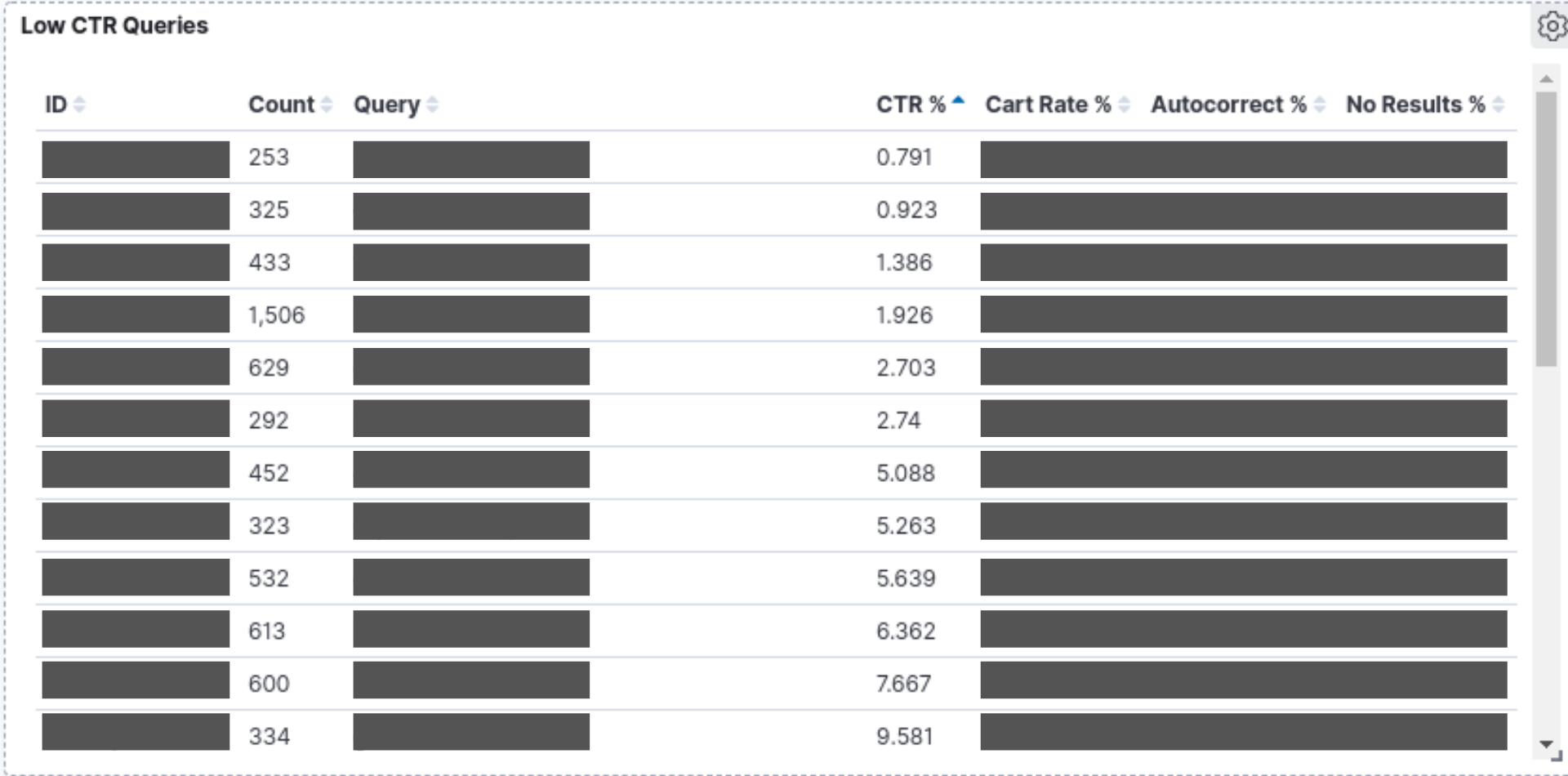
Zero results queries
Another metric that you can check right now is those search queries that present zero results. It means that users search for something and get “sorry we don’t have this product” result. The problem is evident here as well, and you have to understand the reasons behind this because you are most likely missing on potential revenue here.
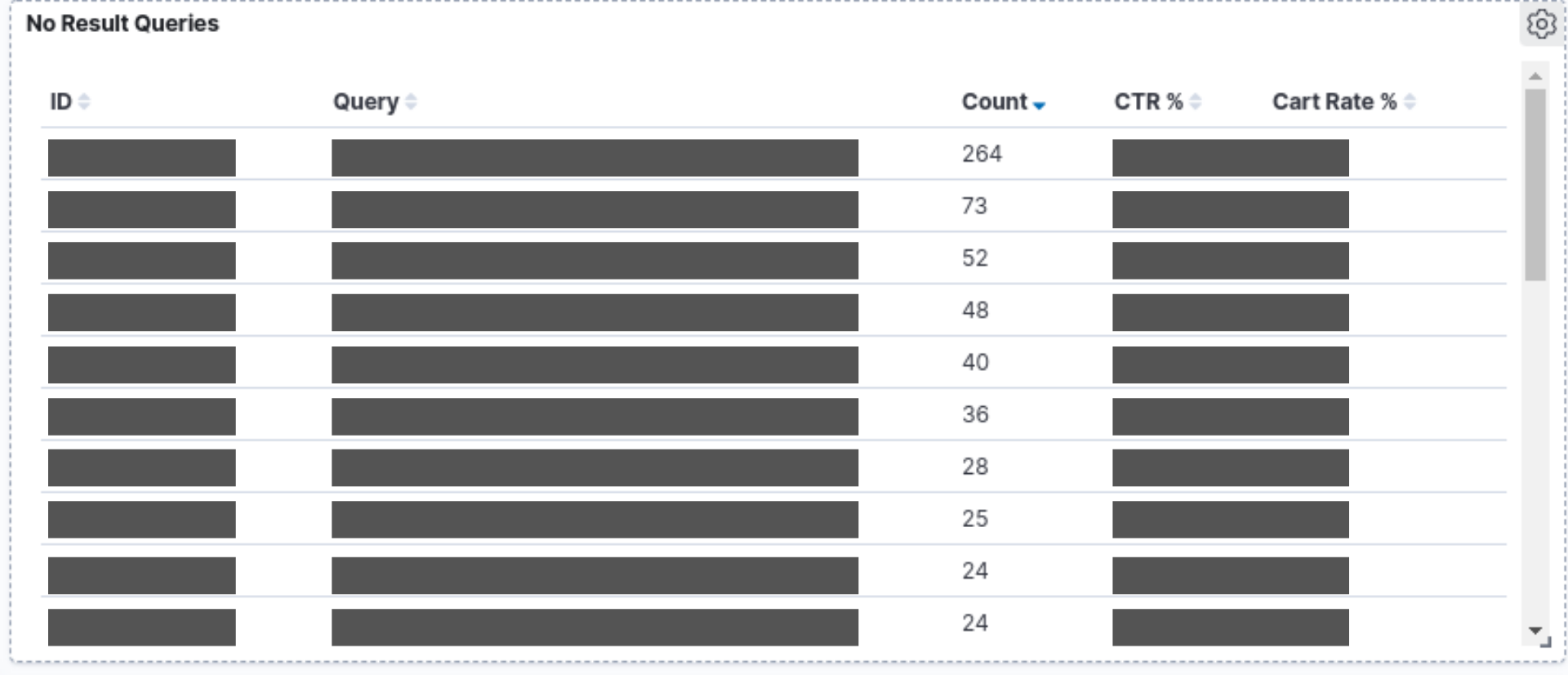
Most companies are probably already tracking and measuring these types of queries, but the important part here is to understand why this is happening. In the following section, we will tell you how to understand what could potentially influence these underperforming queries.
2. Identify Patterns Of These Issues
The second step here is to find patterns and understand why these click-through rates or no results are happening.
Your e-store doesn’t have these products in your supply
One of the reasons and a self-explanatory one might be that you simply don’t sell these products. Thus, this could be a great place where your product department gets ideas for products offering extensions. Just think about this, buyers are already coming to your store to buy these products, you simply need to provide it to them. This could be a rapid win and revenue booster for your company.
” Zero results queries are a great source of products offering extension ideas. “
Your results don’t match searcher’s intent
Another reason why they might happen might be that you sell these products, but users are not able to discover it. Most probably it is the case that they are using different kind of phrasing than your search expects, thus your search results are simply irrelevant. For example, users are typing “belt”, but your search displays such results as trousers or dresses with belts, because it’s taking data from product title/category, where in your product data, you have the keyword “belt”. Thus, your search engine is not able to comprehend this query properly.

Your data is not processed well
The next type of pattern could be related to data processing. Let’s take the same example, where the user is searching for “belt”. Even though you sell belts, your search engine is not able to understand that users are looking specifically for belts and not a vest where “skirt and belt is not included”. This is happening because the data is poorly processed. So, in this case, you should fix your search engine so it could understand your data.

This pattern becomes even more problematic when users are searching using long and complex queries, for instance, “black belt for women”, or even longer ones. Most probably, these queries are in the long tail, as they are not very frequent. However, you have not to forget them as well, as although they are not very frequent, they can take up to 80% of all of your unique search queries, so there is much money there as well.
You have to check more than just the top 100 underperforming queries in the head if you want to see the big picture, and take advantage of all of your revenue potential. For example, if you take 100 most popular search phrases that have a low CTR, also calculate what the total percentage of all of these search queries was. This way, you will understand the effect it will have if you solve them. Also, it should help you to understand what solutions you need to find.
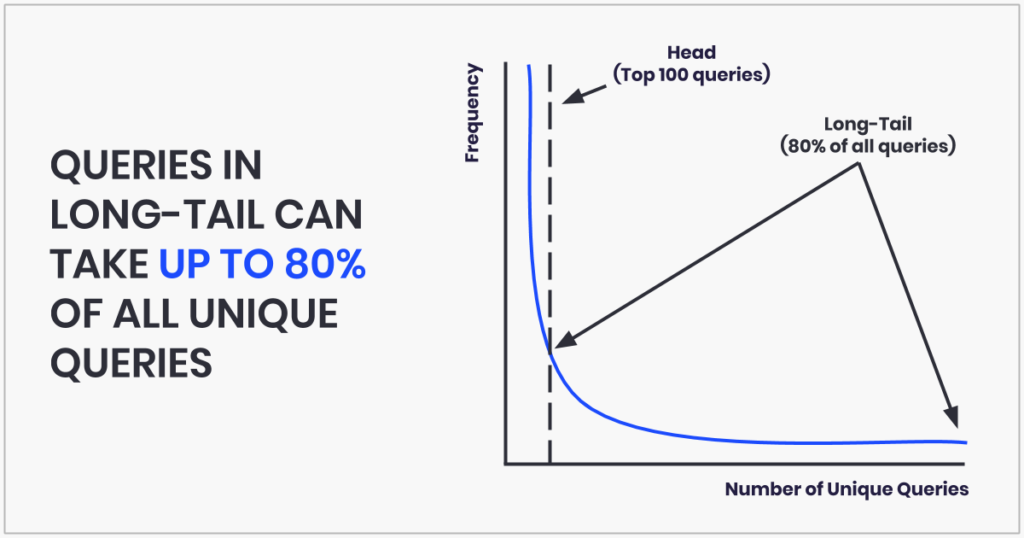
3. Solve Those Issues In a Scalable Way
Adding synonyms, a.k.a. manual hardcoding
One of the low-hanging fruits that you could do quickly is manually setting synonyms – we call it hardcoding. If, after analyzing your data, you see that some of the underperforming queries are getting many hits, it’s worth doing that.
Let’s take an elementary example when users are typing “knives”, but your search engine doesn’t understand that, because it’s taking data from product title/product category, and in your product data, you only have the keyword “knife”, thus, your search engine is not able to comprehend this query properly. Imagine that you see that “knives” are getting 1000 searches per month, that’s quite a significant number, especially if you own a smaller e-store. In this case, you just need to spend a couple of minutes on adding a new synonym “knives = knife”, and it will be fixed.
If not done right, manual adjustments can damage your conversions
But everything is not that simple, and there are many issues with these manual adjustments. Here we would like to use a real-life illustration of one of our clients, who are selling sporting goods.
Many users were searching for “Adidas shoes”; however, the company did not offer Adidas brand shoes at that moment, so users used to get zero results page for this query. Seeing that the query was popular but not performing well, the company decided to introduce a new synonym, “Adidas shoes=shoes”. As a result, when users were searching for Adidas shoes, the search presented SERP with all the shoes that the store has to offer, but not Adidas brand.
Solutions like this are potentially dangerous, as the results are still not matching the user’s intent – the user gets to see all other brand shoes, but not the ones they were actually looking for. In cases like this, users feel frustrated and may result in not buying anything at all, and leaving to the competitors’ site. Thus, it might not help, and it might even decrease your conversions.
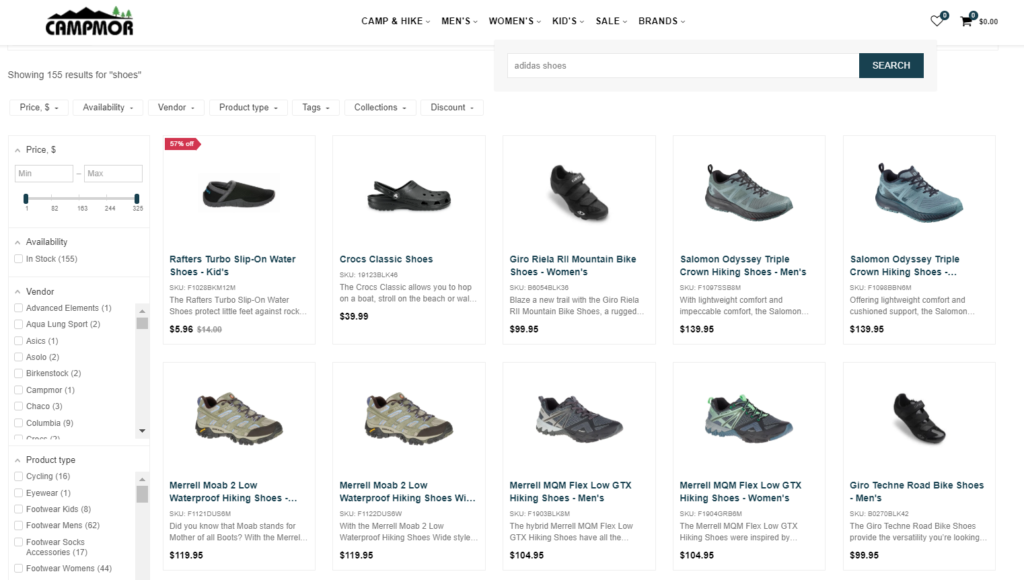
Manual adjustments cause technical debts
Let’s continue with the example with “Adidas shoes”. After some time, that company decided to introduce Adidas shoes to their assortment, but they forgot that they already overruled this query with manual adjustment “Adidas shoes=shoes”. Thus, they created a technical debt here, or as we like to call it search debt. For some time, when users were looking for “Adidas shoes”, the users still couldn’t see relevant results, even though the company started offering the shoes. The logic is pretty simple – the more manual adjustments you have, the more maintenance you create, as you must remember, all of the manual changes you made.
What is Search Debt?
Search Debt – is a term in the development of site search that represents the associated cost of extra work in the future caused by selecting a limited solution now rather than using a better method, which would take more time.
We focused a lot on adding synonyms, but there are many other actions, which fall under hardcoding, such as setting-up boosts, putting redirects, modifying ranking, etc.
Let’s take a look at another example with setting redirects. Imagine you see that the long-tail query “Lenovo 16 gigabyte RAM notebook” is returning zero results page. You decide to manually create a redirect for this query to some more relevant landing page you created for this query. This is a bit more time-consuming, but it can help you to solve the issues.
However, the problems still stay the same – you need a lot of human resources to create thousands or even hundreds of thousands of possible redirections to these landing pages. These redirections/landing pages are not dynamic to your continually changing assortment. s. Also, you’re still creating this search debt, as product assortment is changing – some products run out of stock, new products are introduced, and so on.
The more manual adjustments you have, the more maintenance you create.
Manual hardocing is not a scalable solution
We already mentioned lots of points on why manual adjustments can be potentially harmful to your eCommerce business. However, the way we see it, the most significant problem with this method is that it is not a scalable solution.
What do we mean by that? Well, with hardcoding, you only fix one individual problem, and if another similar problem appears, you’ll have to do it again. And if you own a big eCommerce store with thousands or even millions of similar cases, trying to overhaul all of them isn’t a very efficient way, is it?
One more problem here is that synonyms cannot solve all your issues, for example, let’s take a query “black belt” – you cannot put “black belt = belt”, as not all belts are black. You have to understand that in most of these cases, the problem lay in the algorithm. It’s often an issue with the stemming algorithm. And as we at SearchNode work with probably most of the European countries, all of them have their unique languages, and all of them require custom stemming algorithms and natural language processing algorithms.
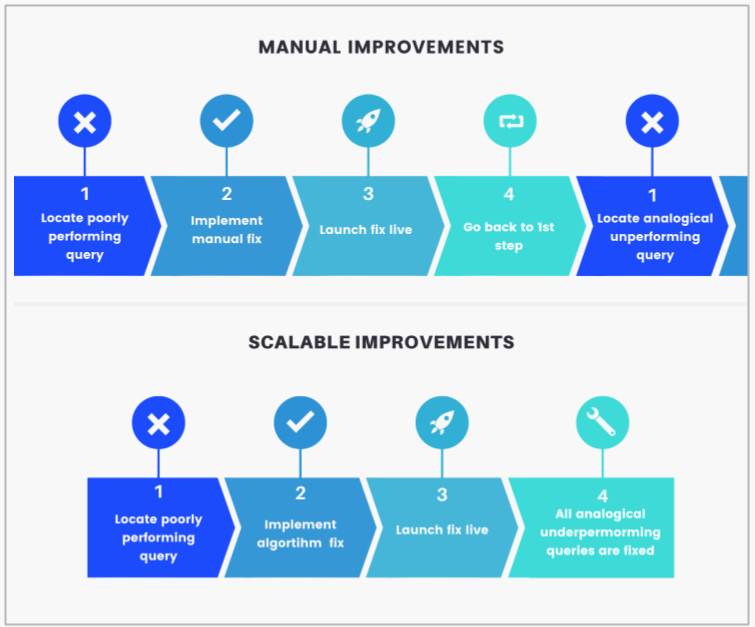
The answer lays in your algorithms
So how to break the habit of manual work? You should always try to find how the machine could solve these patterns that you found so it would never happen again, and you won’t need to stress out about all these manual adjustments.
If you’re building your site-search in-house, most probably, you should get the product manager together with a development team, and they would need to work on that.
If you work with some search provider, the first option is to fix it yourself. However, it could be that you will not be able to change the algorithms and go deep into the product yourself. In this case, you’ve got to ask them.
Just keep in mind that, if you have less than 50,000 search queries, usually algorithmic changes will not make much sense for you, as you don’t have huge search volumes. But if you have more search queries, algorithmic improvements can help you to create scalable search improvements. This is actually what we are doing when working with our clients. So it means that every time you fix an algorithm, you solve thousands of possible and potential search queries, not just case-by-case, and that’s the way a genuine continuous search improvement should be made.
4. Test, Analyze & Measure
It doesn’t matter if you decide to go with the manual adjustments or try making scalable solutions work, you still must understand the value of it.
What we usually do at SearchNode, we look at how the CTR is evolving for specific queries. For instance, we look at a graph of the top 500 search phrases with low CTR, to see how it evolved over time. Let’s say we take the new client, whose search queries with low click-through rates are ~5% of all of their search queries – quite a high number. We keep monitoring the data and we see that over time it is going lower. After a few months of intensive work, we see that the low CTR search queries are just 0,3% of all of the search queries. You could do the same thing with no results search queries. This is one of the ways of how you can measure the value. Of course, don’t forget that new cases are always coming up. So, this job will never end, but it will take less time over the years.
Another way that we also often apply when working with our clients is A/B testing. If you make some significant changes in your search or launch a new algorithm, for example, a new stemming algorithm, we highly recommend conducting an A/B test. This way, you will be able to tell how much more money potentially you will earn when you solve specific search problems.
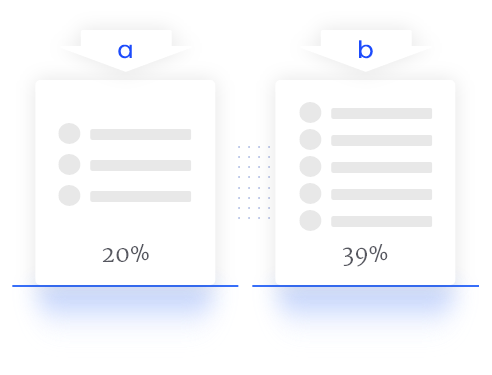
For instance, we recently had a case with one of our clients, who sells goods for sports. They had an issue regarding seasonality. In the summertime, when people were typing “gloves”, they expected to see gloves related to summer sports, like bicycle gloves. And in the winter, users want to find gloves that are for skiing or snowboarding. We detected this issue, and we decided to find a scalable way to solve this. Thus, we implemented a new ranking algorithm, which uses machine learning, and by analyzing sales data and users’ behavior decides what to rank. Also, we tweaked around three algorithms and a couple of configuration steps. To be sure that our changes are working correctly, and is a potential revenue source, we started an A/B test with the previous version. When we reached statistical significance, we saw that by implementing this scalable solution, we were able to raise the conversion rate by 4,2%, which was a lot in terms of money.
Testing, analyzing, and measuring the data is the most important part of continuous search improvements.
To wrap this up, testing, analyzing, and measuring the data is probably an essential part of continuous search improvements, as it will help you understand, what’s working, and what’s not. Also, this way, you will be able to realize the accurate scale and impact of continuous improvements.
How SearchNode Continuously Improves Searches Of Its Clients
We presented a suggestion on how continuous improvement could be run in your company, but it’s up to you to create the most efficient process. As an example, we want to tell you how the continuous improvement process is usually done when the company is working with us.
1. Hypotheses are raised by clients search team or dedicated SearchNode consulting team, based on search data;
2. Product owner (client) decides which hypothesis shall be tested from the joint list;
3. SearchNode engineers develop a new algorithm and set up an A/B tested if needed;
4. We collect data and valuable metrics until it reaches statistical significance;
5. We collect some more data, on how the algorithm performs, and how we can improve it further;
a. If we are not satisfied with A/B test results, we release a second iteration, based on the data we collected, and release a new version of the test;
b. If results are satisfying, we launch a new algorithm
This process is being repeated until we achieve the expected result; if not, we keep the old algorithm running.
We hope this article was useful and you enjoyed reading it! The key takeaway from this article is that site-search improvement is a never-ending process, and you have to try hard, to enjoy the fruits of your labors. If you’d like to get some more ideas on how your search could be improved, we recommend the “18 eCommerce Site Search Best Practices for 2020” article, full of fresh ideas, trends, examples, and best practices.
Also, we would love to hear about site search improvement practices at your company. Please, comment on your experience in the comments section below!

